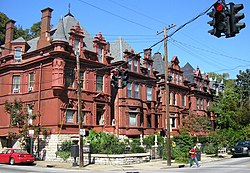Old Louisville Residential District | |
 Werne's Row at the corner of 4th and Hill | |
| Location | Louisville, Kentucky |
|---|---|
| Built | 1850-1920s |
| Architectural style | Late Victorian |
| Website | oldlouisville.org |
| NRHP reference No. | 84001583[1] |
| Added to NRHP | July 12, 1984 |

Old Louisville is a historic district and neighborhood in central Louisville, Kentucky, United States. It is the third largest such district in the United States, and the largest preservation district featuring almost entirely Victorian architecture.[2][3] It is also unique in that a majority of its structures are made of brick, and the neighborhood contains the highest concentration of residential homes with stained glass windows in the U.S.[3] Many of the buildings are in the Victorian era styles of Romanesque Revival, Queen Anne, or Italianate, and many blocks have had few or no buildings razed. There are also several 20th-century buildings from 15 to 20 stories.
Old Louisville consists of about forty-eight city blocks and is located north of the University of Louisville's main campus and south of Broadway and Downtown Louisville, in the central portion of the modern city.[4][5] The neighborhood hosts the annual St. James Court Art Show on the first weekend in October.
Old Louisville was built as a suburb of Louisville starting in the 1870s, nearly a century after the city was founded. It was initially called the Southern Extension, and the name "Old Louisville" did not come into use until the 1960s. Old Louisville was initially home to some of Louisville's wealthiest residents, but saw a decline in the early and mid-20th century. Following revitalization efforts and gentrification, Old Louisville is currently home to a diverse population with a high concentration of students and young professionals.
- ^ "National Register Information System". National Register of Historic Places. National Park Service. January 23, 2007.
- ^ "Louisville Facts & Firsts". LouisvilleKy.gov. Archived from the original on October 6, 2014. Retrieved December 14, 2009.
- ^ a b "What is Old Louisville?". Old Louisville Guide. Archived from the original on November 27, 2009. Retrieved December 14, 2009.
- ^ Fernandez, Maisy (September 29, 2004). "What's Old is New". Velocity. p. 8.
- ^ Yater, George H. (2001). Encyclopedia of Louisville. University Press of Kentucky. pp. 674–675. ISBN 0813128900.

